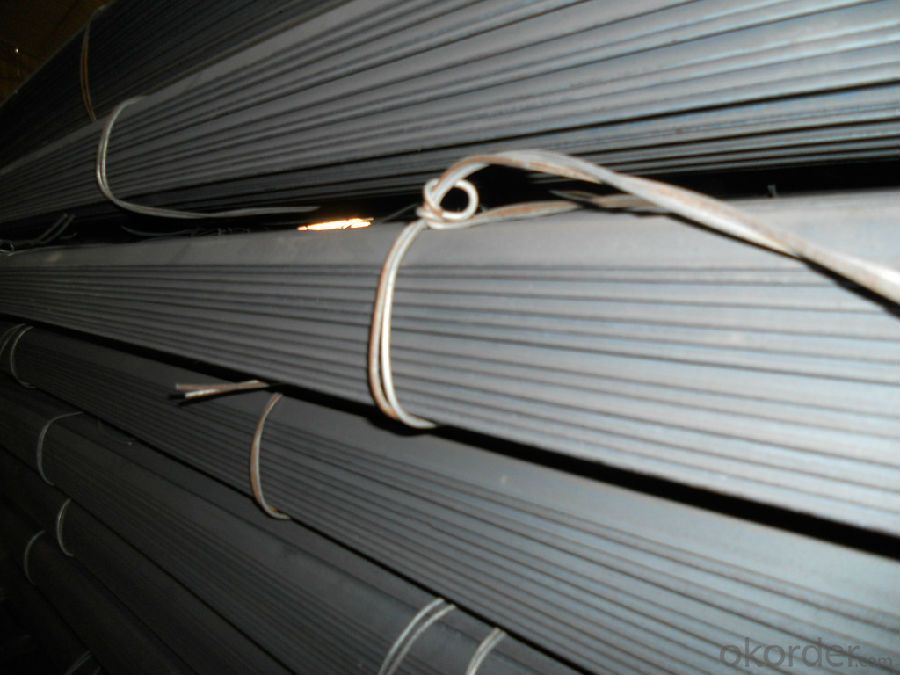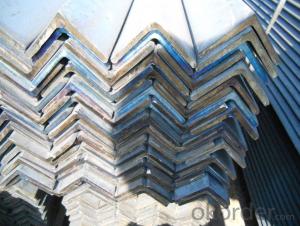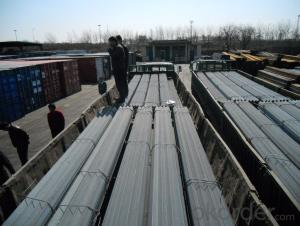Structure Steel Equal Angle Bar
- Loading Port:
- China Main Port
- Payment Terms:
- TT or LC
- Min Order Qty:
- -
- Supply Capability:
- -
OKorder Service Pledge
OKorder Financial Service
You Might Also Like
Product Description:
OKorder is offering Structure Steel Hot Rolled Angle Bar at great prices with worldwide shipping. Our supplier is a world-class manufacturer of steel, with our products utilized the world over. OKorder annually supplies products to European, North American and Asian markets. We provide quotations within 24 hours of receiving an inquiry and guarantee competitive prices.
Product Applications:
Trusses;
Transmission towers;
Telecommunication towers;
Bracing for general structures;
Stiffeners in structural use.
Product Advantages:
OKorder's Structure Steel Hot Rolled Angle Bar are durable, strong, and resist corrosion.
Main Product Features:
· Premium quality
· Prompt delivery & seaworthy packing (30 days after receiving deposit)
· Corrosion resistance
· Can be recycled and reused
· Mill test certification
· Professional Service
· Competitive pricing
Product Specifications:
1.Standards:GB,ASTM,BS,AISI,DIN,JIS
2.Invoicing on theoretical weight or actual weight as customer request
3.Material: JIS G3192,SS400;SS540.
4. Payment terms:
1).100% irrevocable L/C at sight.
2).30% T/T prepaid and the balance against the copy of B/L.
3).30% T/T prepaid and the balance against L/C
5.Sizes:

EQUAL ANGLES SIZES |
| ||
a(mm) | a1(mm) | thickness(mm) | length |
25 | 25 | 2.5---3.0 | 6M/12M |
30 | 30 | 2.5---4.0 | 6M/12M |
38 | 38 | 2.5 | 6M/12M |
38 | 38 | 3.0---5.0 | 6M/12M |
40 | 40 | 3.0---6.0 | 6M/12M |
50 | 50 | 3 | 6M/12M |
50 | 50 | 3.7---6.0 | 6M/9M/12M |
60 | 60 | 5.0---6.0 | 6M/9M/12M |
63 | 63 | 6.0---8.0 | 6M/9M/12M |
65 | 65 | 5.0---8.0 | 6M/9M/12M |
70 | 70 | 6.0---7.0 | 6M/9M/12M |
75 | 75 | 5.0---10.0 | 6M/9M/12M |
80 | 80 | 6.0---10.0 | 6M/9M/12M |
90 | 90 | 6.0---10.0 | 6M/9M/12M |
100 | 100 | 6.0---12.0 | 6M/9M/12M |
120 | 120 | 8.0-12.0 | 6M/9M/12M |
125 | 125 | 8.0---12.0 | 6M/9M/12M |
130 | 130 | 9.0-12.0 | 6M/9M/12M |
140 | 140 | 10.0-16.0 | 6M/9M/12M |
150 | 150 | 10---15 | 6M/9M/12M |
160 | 160 | 10---16 | 6M/9M/12M |
180 | 180 | 12---18 | 6M/9M/12M |
200 | 200 | 14---20 | 6M/9M/12M |
5. Material Specifications:
Grade | Yield Strength,N/mm² | Extension Strength N/mm² | |||
Thickness of Steel,mm | |||||
≦16 | >16-≦40 | >40-≦100 | >100 | ||
SS330 | ≧205 | ≧195 | ≧175 | ≧165 | 330-430 |
SS400 | ≧245 | ≧235 | ≧215 | ≧205 | 400-510 |
SS490 | ≧285 | ≧275 | ≧255 | ≧245 | 490-610 |
SS540 | ≧400 | ≧390 | - | - | ≧540 |
Packaging & Delivery of Angle Steel
1. Transportation: the goods are delivered by truck from mill to loading port, the maximum quantity can be loaded is around 40MTs by each truck. If the order quantity cannot reach the full truck loaded, the transportation cost per ton will be little higher than full load.
2. With bundles and load in 20 feet/40 feet container, or by bulk cargo, also we could do as customer's request.
3. Marks:
Color mark: There will be color marking on both end of the bundle for the cargo delivered by bulk vessel. That makes it easily to distinguish at the destination port.
Tag mark: There will be tag mark tied up on the bundles. The information usually including supplier logo and name, product name, made in China, shipping marks and other information request by the customer.
If loading by container the marking is not needed, but we will prepare it as customer request.
FAQ:
Q1: Why buy Materials & Equipment from OKorder.com?
A1: All products offered byOKorder.com are carefully selected from China's most reliable manufacturing enterprises. Through its ISO certifications, OKorder.com adheres to the highest standards and a commitment to supply chain safety and customer satisfaction.
Q2: How do we guarantee the quality of our products?
A2: We have established an advanced quality management system which conducts strict quality tests at every step, from raw materials to the final product. At the same time, we provide extensive follow-up service assurances as required.
Q3: How soon can we receive the product after purchase?
A3: Within three days of placing an order, we will begin production. The specific shipping date is dependent upon international and government factors, but is typically 7 to 10 workdays.
Q4: What makes stainless steel stainless?
A4: Stainless steel must contain at least 10.5 % chromium. It is this element that reacts with the oxygen in the air to form a complex chrome-oxide surface layer that is invisible but strong enough to prevent further oxygen from "staining" (rusting) the surface. Higher levels of chromium and the addition of other alloying elements such as nickel and molybdenum enhance this surface layer and improve the corrosion resistance of the stainless material.
Q5: Can stainless steel rust?
A5: Stainless does not "rust" as you think of regular steel rusting with a red oxide on the surface that flakes off. If you see red rust it is probably due to some iron particles that have contaminated the surface of the stainless steel and it is these iron particles that are rusting. Look at the source of the rusting and see if you can remove it from the surface.
Images:


- Q:How do you prevent corrosion on steel angles?
- One effective method to prevent corrosion on steel angles is by applying a protective coating such as paint or zinc. This barrier creates a physical barrier between the steel and the corrosive elements in the environment, preventing direct contact and reducing the chances of corrosion. Regular maintenance and inspection, along with promptly addressing any signs of damage or rust, can also help prevent corrosion on steel angles.
- Q:Can steel angles be used for foundation supports?
- Yes, steel angles can be used for foundation supports. Steel angles provide structural support and stability, making them suitable for various construction applications, including foundation supports.
- Q:How do you calculate the deflection of a steel angle under load?
- To calculate the deflection of a steel angle under load, you can use the principles of structural engineering and the concept of beam deflection. The deflection of a beam is the degree to which it bends or sags under an applied load. Firstly, you need to determine the properties of the steel angle, such as its cross-sectional area, moment of inertia, and modulus of elasticity. These properties can be obtained from the manufacturer's specifications or through testing. Next, you should determine the type of loading the steel angle will be subjected to, such as a uniformly distributed load or a concentrated load. The magnitude and distribution of the load will affect the deflection. Once you have the necessary information, you can use various equations and formulas to calculate the deflection. One commonly used equation is the Euler-Bernoulli beam equation, which relates the deflection of a beam to the applied load, its length, and the properties of the material. The equation for calculating the deflection of a simply supported beam, such as a steel angle, under a uniformly distributed load is: δ = (5 * w * L^4) / (384 * E * I) Where: δ is the deflection w is the uniform load per unit length L is the length of the beam E is the modulus of elasticity of the steel angle I is the moment of inertia of the steel angle about its neutral axis For a concentrated load, the equation would be slightly different. Additionally, if the steel angle is not simply supported but has different boundary conditions, such as being fixed at one end, the equations will vary accordingly. It's important to note that these equations provide an estimate of the deflection, assuming the steel angle behaves linearly and elastically. In reality, there might be other factors affecting the deflection, such as material imperfections or non-linear behavior under high loads. Therefore, it is always recommended to consult a structural engineer or utilize specialized software for a more accurate and comprehensive deflection calculation.
- Q:Can steel angles be used for reinforcing concrete structures?
- Yes, steel angles can be used for reinforcing concrete structures. Steel angles provide additional strength and stability to concrete structures, increasing their load-bearing capacity and resistance to bending and shearing forces. These angles are typically used to reinforce corners, edges, and joints, helping to prevent cracking and enhance the overall durability of the structure.
- Q:Can steel angles be used for framing windows or doors?
- Framing windows or doors is indeed possible with steel angles. In construction, steel angles are widely employed for their robustness and endurance. As framing material, they offer essential support and stability. Moreover, steel angles can be easily tailored and trimmed to the desired length, rendering them suitable for framing windows and doors of different dimensions. Furthermore, by welding or bolting steel angles together, a robust frame can be fashioned capable of enduring substantial loads and furnishing the indispensable support for windows and doors.
- Q:How do steel angles contribute to the durability of a structure?
- Steel angles contribute to the durability of a structure by providing additional strength and stability. They are used to reinforce connections and support load-bearing components, ensuring structural integrity and withstanding various forces such as gravity, wind, and seismic loads. The angle shape of the steel allows for efficient distribution of stress and prevents bending or deformation, enhancing the overall durability and longevity of the structure.
- Q:Can steel angles be used in the construction of shopping malls?
- Yes, steel angles can be used in the construction of shopping malls. Steel angles are versatile structural components that can provide support and stability to various elements of a building, including shopping malls. They are commonly used in the construction industry for framing, bracing, and reinforcing structures. Steel angles can be used to support the walls, roof, and floors of shopping malls, ensuring the structural integrity of the building. Additionally, they can be used in the construction of staircases, escalators, and mezzanines within the shopping mall. The use of steel angles in shopping mall construction offers several advantages, including their durability, strength, and cost-effectiveness.
- Q:Can steel angles be used for temporary or removable structures?
- Yes, steel angles can be used for temporary or removable structures. Steel angles are versatile and commonly used in construction for various applications, including temporary or removable structures. They are often used as framing elements in scaffolding, support structures, and temporary partitions. Steel angles provide structural support and stability, making them suitable for temporary or removable structures that need to be strong and durable. Additionally, steel angles are easy to assemble and disassemble, allowing for convenient installation and removal of the temporary or removable structure.
- Q:Can steel angles be used in storage rack systems?
- Yes, steel angles can be used in storage rack systems. Steel angles provide strength and stability, making them suitable for supporting heavy loads in storage racks. They can be used to create the framework and support beams in the rack system, ensuring durability and safety.
- Q:How does the weight of a steel angle affect its load-bearing capacity?
- The weight of a steel angle does not directly affect its load-bearing capacity. The load-bearing capacity of a steel angle is determined by its dimensions, material strength, and design factors such as the shape and support conditions. However, a heavier steel angle may indicate a higher material density, which could potentially result in increased load-bearing capacity if all other factors remain constant.
1. Manufacturer Overview |
|
|---|---|
| Location | |
| Year Established | |
| Annual Output Value | |
| Main Markets | |
| Company Certifications | |
2. Manufacturer Certificates |
|
|---|---|
| a) Certification Name | |
| Range | |
| Reference | |
| Validity Period | |
3. Manufacturer Capability |
|
|---|---|
| a)Trade Capacity | |
| Nearest Port | |
| Export Percentage | |
| No.of Employees in Trade Department | |
| Language Spoken: | |
| b)Factory Information | |
| Factory Size: | |
| No. of Production Lines | |
| Contract Manufacturing | |
| Product Price Range | |
Send your message to us
Structure Steel Equal Angle Bar
- Loading Port:
- China Main Port
- Payment Terms:
- TT or LC
- Min Order Qty:
- -
- Supply Capability:
- -
OKorder Service Pledge
OKorder Financial Service
Similar products
New products
Hot products
Related keywords




























